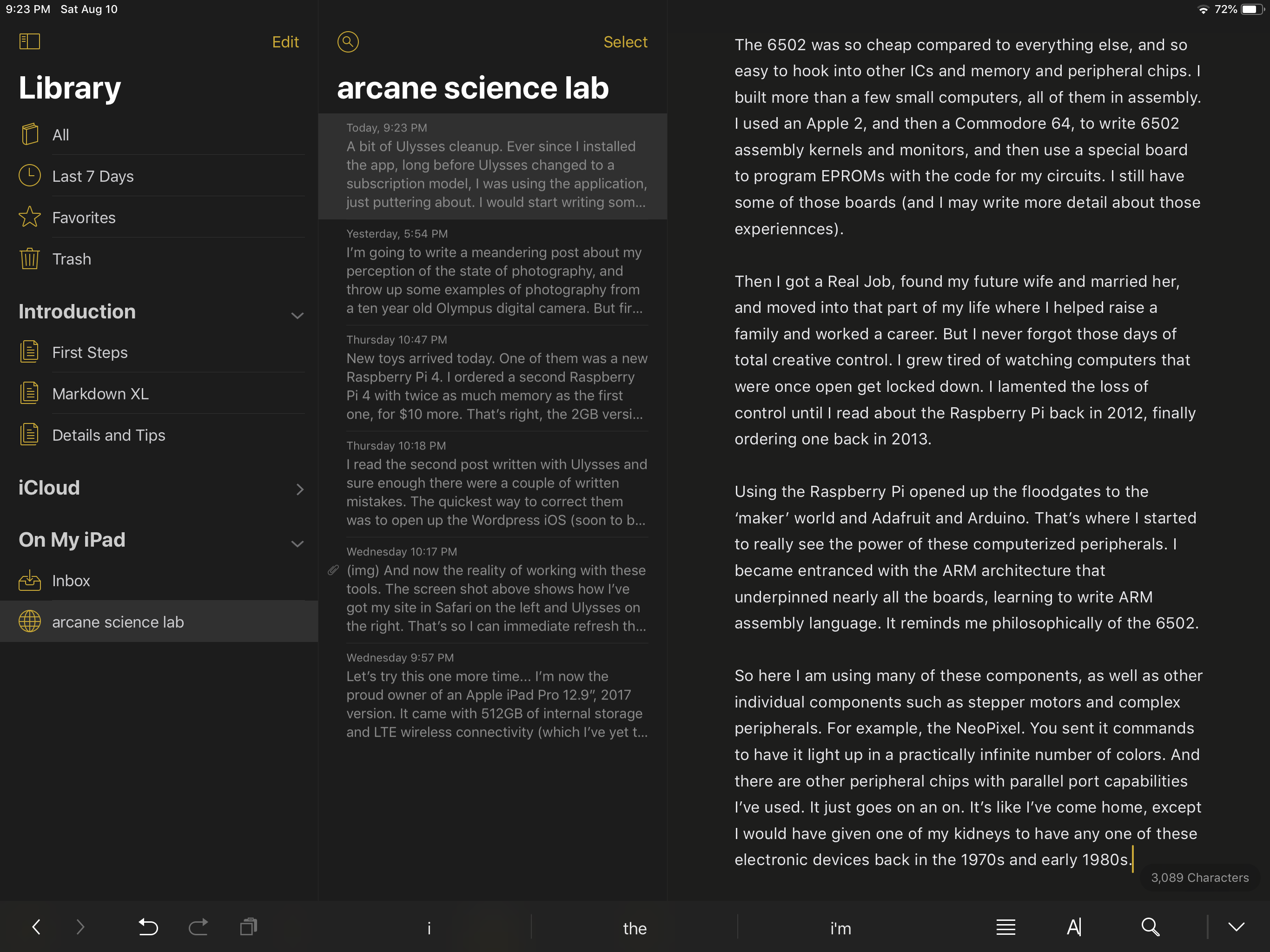
A bit of Ulysses cleanup. Ever since I installed the app, long before Ulysses changed to a subscription model, I was using the application, just puttering about.
I would start writing something, anything, and then I would just walk away and quickly forget. I’ve got all sorts of little (and some big) writing pieces in the Library, all of them uncategorized. Tonight I changed that by creating a category (or group in Ulysses parlance) for the blog named Radarwitch.
I’ll be slowly adding more as time goes on, especially one devoted to using the Raspberry Pi and all the little tiny computers you can get for just tens of dollars. As a kid growing up the best I could find would have been tubes (such as the ubiquitous 12AX7A, first manufactured back in the late 1940s before I was born) or individual transistors (too many to mention by individual name). When I was in high school, shops like Lafayette Electronics and old-school Radio Shacks carried all those parts as well as initial RTL (resistor-transistor logic) and DTL (diode-transistor logic) integrated circuits. They were quite primitive by today’s standards, but they worked and opened up a whole new universe of invention beyond just individual components.
By the time I started engineering school in 1972 I’d ‘graduated’ to Texas Instruments TTL (transistor-transistor logic) SSI (small scale integration). I had stacks of Texas Instruments part manuals around my room, as well as Fairchild, National Semiconductor and Sylvania and a startup by the name of Intel. Everything was socketed and wire-wrapped. While in college I started playing with early 8-bit CPUs, such as the Intel 8080, Motorola 6800, and MOS 6502. Especially the 6502.
The 6502 was so cheap compared to everything else, and so easy to hook into other ICs and memory and peripheral chips. I built more than a few small computers, all of them in assembly. I used an Apple 2, and then a Commodore 64, to write 6502 assembly kernels and monitors, and then use a special board to program EPROMs with the code for my circuits. I still have some of those boards (and I may write more detail about those experiennces).
Then I got a Real Job, found my future wife and married her, and moved into that part of my life where I helped raise a family and worked a career. But I never forgot those days of total creative control. I grew tired of watching computers that were once open get locked down. I lamented the loss of control until I read about the Raspberry Pi back in 2012, finally ordering one back in 2013.
Using the Raspberry Pi opened up the floodgates to the ‘maker’ world and Adafruit and Arduino. That’s where I started to really see the power of these computerized peripherals. I became entranced with the ARM architecture that underpinned nearly all the boards, learning to write ARM assembly language. It reminds me philosophically of the 6502.
So here I am using many of these components, as well as other individual components such as stepper motors and complex peripherals. For example, the NeoPixel. You sent it commands to have it light up in a practically infinite number of colors. And there are other peripheral chips with parallel port capabilities I’ve used. It just goes on an on. It’s like I’ve come home, except I would have given one of my kidneys to have any one of these electronic devices back in the 1970s and early 1980s.

I used to get Lafayette catalogs. i think i bought a CB radio from them back when you still needed a license.
LikeLike
I grew up in Atlanta. At the time I was a junior in high school with a brand new drivers license. I remember there were three locations; Decatur, Greenbriar, and Buckhead. I discovered the Greenbriar location when I was out one day driving to run an errand for my mom. I stopped in and got lost for a few hours. My mom was in a panic when I got home; she thought I’d gotten into an accident and was lying on the side of the road bleeding.
I got into the digital parts side of things because of Apollo and the Apollo Guidance Computer. The AGC was built entirely from RTL, nearly 3,000 Fairchild Semiconductor flatpack dual three-input NOR gates. In the back of my mind I had the crazy idea I could build my own if I could just afford enough surplus chips of the same type. Lafayette carried a lot of RTL chips, but not enough of the kind I needed, and even if they did buying enough of the chips as well as all the other hardware to build out the DSKY (Display Keyboard) with its expensive seven segment LED displays would have bankrupted me and my family.
LikeLiked by 1 person
The AGC/DSKY was unique. It would require ambition and talent to consider building one.
LikeLike